Grant Strate - The Perfect Glass of Dry Sherry
Saturday, December 15, 2007
Wine can clear
The vapors of despair.
And make us light as air. John Gay 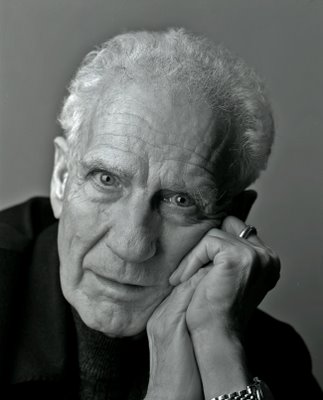 On Saturday, December 8, I photographed for the Georgia Straight, dancer and choreographer Grant Strate who is celebrating his 80th birthday today. There is a big party for him at the Vancouver Dance Centre. Both the Georgia Straight and an article in today's Vancouver Sun describe this man's past as one of the founders of the National Ballet of Canada. There would be no mandate or perhaps space to emphasize Strate's views on dance now. Strate has a bit of problem walking but braved the stairs to my studio. I had given him the option of not coming and I would have photographed him where he would have been more comfortable. I had a chat with him and even though there is lots of laywer influence in his background (he was one) he had some startlingly candid opinions on dance now. I can understand why Wen Wei Wang would consider him an important mentor. When the session was over and I accompanied Strate downstairs, Wen Wei Wang was there to take his beloved teacher to his next press assignment. This morning I thought about Strate. I had been moved not only by Strate's presence in my studio but seduced by piercing blue eyes as good as Peter O'Toole's. 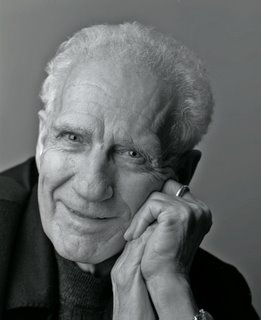 I thought of the solera system for making dry sherries and my favourite pale yellow and dry manzanilla. This system has a relation with dancers handing off their experience to a next generation. I searched these blogs to find out that I had already had the idea before here. This idea that no matter how you dilute an old and perfect sherry, there is a bit of it in the generations of sherry that follow, can be compared to watching such wonderous dancers as Desirée Dunbar (below, left) dance in Vancouver. I think about it every time I watch her dance. 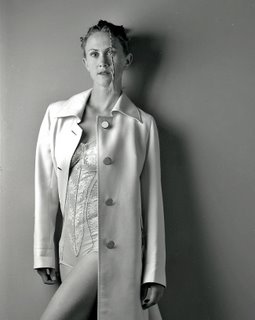 Her teacher and mentor Judith Garay (below, right) studied under American choreographer Martha Graham. There is some Graham in Garay and some of that was passed on to Dunbar. Garay in her position in the faculty of Simon Fraser University in the School for the Contemporary Arts surely has met up with Grant Strate. 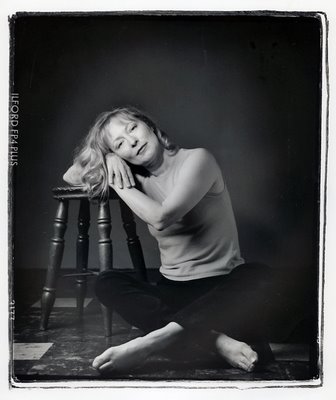 There is a little of Grant Strate in Garay. In my original piece on Strate and sherry here there is a photograph of Strate with dancer choreographer Katheryn Ricketts. She and Strate collaborated. I think of Ricketts teaching my Rebecca jazz dance at Arts Umbrella (she did) and I am excited to know that there is a little bit of the original fine (fino) dry sherry seeping down into present generations of Vancouver dancers who will transfer it to future generations. 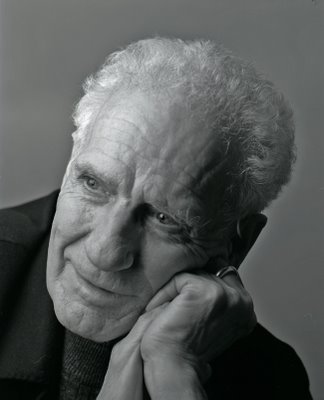 As old dry sherries go, Grant Strate was (and is) a good year.
The Sun Building, Mutant Armadilloes & A Box
Friday, December 14, 2007
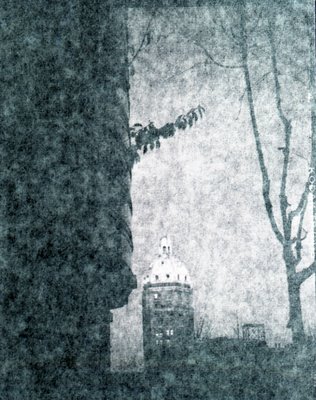 The world's first camera was one that Aristotle observed while resting under a tree. The tree's leaves filtered the noon Greek sun on a summer day. Artistotle noticed a blurry image on the ground. The image was an image caused by the sun going through a little aperture made by leaves that converged forming a tiny opening. If Aristotle had known about lenses and glass he might have tried burning something using the sun. A camera of sorts (and a real chamber it was, and earlier than Aristotle) was Plato's cave. Some slaves with their backs to a cave opening faced a wall. Between the seated, and chained slaves, there was a fire. Light and images coming from above ground were projected by the cave's small entrance on to the wall but the fire made the image even more vague. We know of these deatails since Portuguese Nobel Prize for Literature winner (1988), José Saramago describes the cave, found under a Lisbon shopping mall in his 2000 novel La Caverna (The Cave). 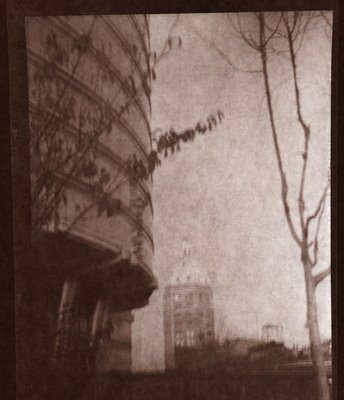 Leonardo da Vinci is almost always given credit for inventing the camera obscura which had all the basics of a modern camera except for a some device to permanently record the captured, but ultimately fleeting light image. And so it was until Frenchman Joseph Nicéphore Niépce (Chalon on the Seine) used a camera device that made a permanent image of the view of the courtyard outside of his workshop window. It was an 8-hour exposure. While the recording medium has consisted of sensitized paper, sensitized silver plated copper, sensitized tin and sensitized glass it didn't achieve a real breakthrough until 1888 when George Eastman thought of sensitizing a flexible and transparent plastic called celluloid. Nothing changed until the advent of digital cameras with their CCD and CMOS sensors. But what has remained the same is the box. All cameras consist of: 1. Lens, sometimes with an attached shutter. 2. box. 3. A sensitized light capturing material (film) or a digital sensor. Sometimes the shutter is right before the film or sensor. And that pretty well defines a camera, chamber or box. 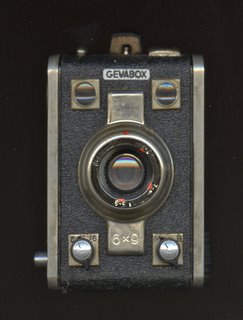 An example of a pretty basic box is my German made Gevabox. It has a glass miniscus lens (quite primitive), three f-stops (8, 11, 16) and a 1/30 shutter speed plus B for bulb (the shutter stays open as long as you press the shutter button). It uses 120 sized roll film and takes 8 6x9 cm images that are not always in sharp focus. The two viewfinders show a distant approximation of what you are going to get. Dr Joseph Ignace Guillotin might have in some way have been an influence as this camera will chop heads with alarming regularity. But sometimes it surprises. Some years ago, two, three or five? I don't remember I must have gone to downtown Vancouver and squeezed a few shots of the old Sun (Vancouver Sun) Tower. I found the exposed roll of Kodak Technical Pan (ISO 25) in a drawer. I processed it a few days ago. 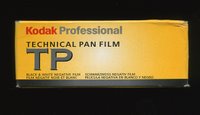 I found two interesting negatives which I placed on my Epson V700 scanner. Before closing the lid (this scanner scans from above and from below, at the same time) I placed a sheet of white letterhead paper on each negative. Here are the results. I sent the pair of photos to my friend Gordon Price (the only Vancouver City Councillor who was never culturally challenged and supported and supports the arts). He ran them in his extremely popular civic, city planning, density planning,etc blog called pricetags here. He nailed for me why he likes them by saying it has all to do with the juxtaposition of the old with the new. My Texan friend Howard Houston who lives near Austin (I like to write it like that) commented as follows: A thousand years after the Fall of Civilization, an intrepid explorer with an ancient box camera captures an image of the radioactive remains of downtown Vancouver. Shortly after taking this photo, the explorer was devoured by one of the seemingly ubiquitous mutant armadilloes that migrated North from Texas after the fall. Barely escaping with her life, the explorer's beautiful assistant saves his work for posterity, wearing something slinky and low cut.
Opera Sushi Redux II
Thursday, December 13, 2007
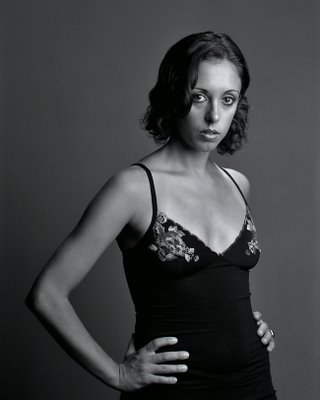
Something amazing happened last night. Rebecca and I went to Opera Sushi and Verdi's La Traviata with Angela Gheorghiu and Frank Lopardo was not playing on the TV.
Instead it was the ending of Goerges Bizet's Carmen performed by the Metropolitan Opera in 1987 with Greek mezzo-soprano Agnes Baltsa and Spanish tenor José Carreras. We saw Don José knife Carmen and when it was over the opera started again.
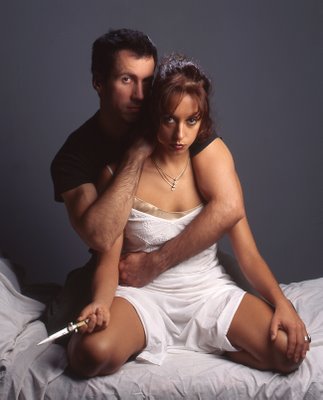
During the overture when Rebecca saw how large, orchestra conductor, James Levine was, she said, "He looks like heart attack material." I told her that Levine was still alive 20 years later. As soon as Carmen appeared (and I had to explain how women rolled cigars on their thighs!) Rebecca thought that Baltsa was not as pretty as Gheorghiu. She was right. But I explained the Baltsa looked the part as she looked like a gypsy. Immediately Rebecca asked where gypsies came from and I had to explain. Luckily I was able to skirt the fact that Baltsa was a lot more provocative in her very low cut dress with the red rose between her breasts.
When Carmen notices Don José and bangs him on the forehead with her rose, Rebecca immediately remembered that very scene in Ballet BC's original 2003 production of Carmen as a ballet. She said, "Sandrine Cassini was as sexy as Baltsa (so much for skirting that explanation)."
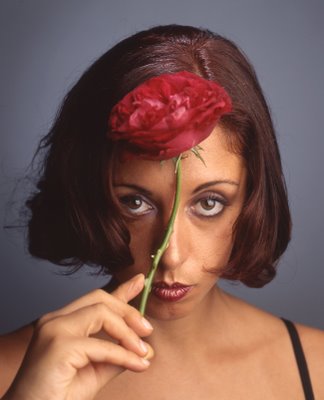
So I thought of Sandrine Cassini (she is in Germany) and remembered that little quote from my Best Quotations for All Occasions (I purchased it in Austin in 1961) about love:
Man loves little and often,
women much and rarely.
That fine little quote, that pretty well explains my infatuation with the marvelously sexy Cassini, was attributed to someone called Basta.
Carmen at Opera Sushi gave me an ample excuse to post these pictures of Cassini all over again. In the second photograph she is with dancer Edmond Kilpatrick who played Don José. I wrote about her here, here, and here
As we left Opera Sushi, the sushi chef said, "Goodbye Rebecca." We suspect that he must have read the previous blog.
Dance In The Raw
Wednesday, December 12, 2007
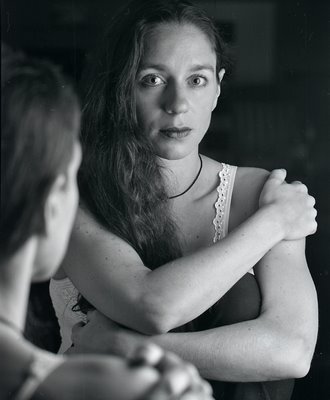
Every once in a while I get calls from young photographers who want to watch me work. In most cases I turn down their requests as the majority of my photographic sessions are one-on-one and a bystander would break the bond on which I depend on for my photograph. I might take only (recently, in particular) five or six photographs but the short session is preceded by a chat session where I talk with my subject and attempt to find a common ground. Years ago when those phone calls were much more frequent I did have jobs with makeup artists and stylists so I would sometimes agree to let that young photographer have a look. But then they made me nervous. I know of myriad ways of breaking equipment because I have broken equipment in myriad ways. I found myself watching these guys hoping they would not trip on some cable and have my lights come crashing down.
But I can see the value of seeing someone with more experience work. This is why I consider myself so fortunate to get, once in a while a communication like the one that follows:
Choreography by Day Helesic/MovEnt
Performance by Day Helesic and Chengxin Wei
Please join us for one of our open rehearsals of Around the Block (Excerpt), a newly created section of MovEnt's second full length choreography, Around the Block. Feedback and discussion are welcome!
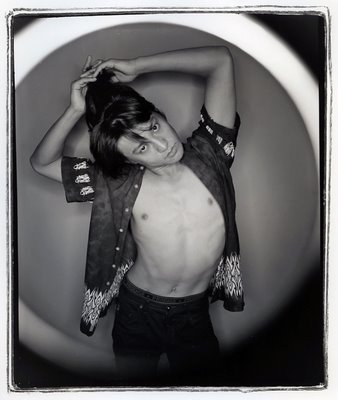
From the first blush of romance, to moments of turmoil and solitude, to a superhuman effort to revive what has been lost, a couple who has been “around the block” discover that nothing stays the same forever.
The full length Around the Block is a choreography inspired by New York City, a city rife with urban turmoil. The collision of architectural styles, the collision of cultures and the collision of people will inspire an energetic dance work that delves deep into the inner workings of an urban centre. Four characters will discover their place within this metropolis of strangers.
Open rehearsal schedule:
Monday Dec 10th: 8:30pm at The Dance Centre (Jarislowsky studio, 3rd floor)
Tuesday Dec 11th: 8:30pm at The Dance Centre (Jarislowsky studio, 3rd floor)
I attended last night sessions. I would never know why it wasn't full of people jumping for the chance to see two of Vancouver's finest dancer/choregraphers do their stuff. There were two young women, Tara Cheyenne Friedenberg and her husband Marc Stewart. Stewart was there, as the music composer, and so was lighting designer Alan Brodie. Neither of them had seen the excerpt before. This was to be the fourth performance. It was raw, and done on a sticky (dangerous) floor. The lighting was a depressing overhead that at one time would have induced on me a migraine.
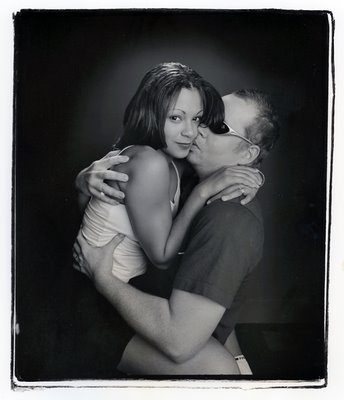
And it was wonderful as I felt unique in being able to get a glimpse of a dance at its beginning with the eventual pleasure of seeing the finished product in 2009. I tried to put myself in the place of the composer and the lighting designer. What would I cook up?
And as always I found myself marveling at the intelligence and the articulate demeanor of our Vancouver dancers. In a recent photo session with National Ballet of Canada founder Grant Strate I commented on this. He told me that there were some "not so articulate" dancers out there but I have been lucky or perhaps we are lucky in Vancouver to have this intelligent and passionate bunch.
The raw excerpt had lots of genuine reality in which Helesic and Wei acted tired and angry as they explored a relationship compressed to 30 minutes and representing one street of a complete turn (4 blocks) of a New York City block. They will share the work with dancers Amber Funk Barton (seen above with husband Chris) and Shay Kuebler, holding his tap shoes.
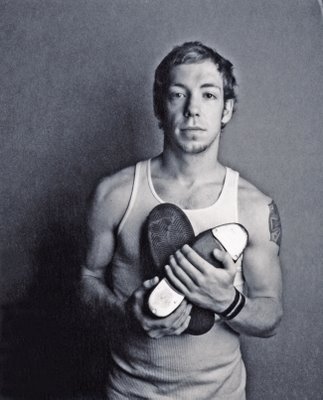
Helesic's experiment is an interesting one. She is choreographing her impression of New York City now even though she plans to visit the city in June, 2008, for the first time. Interesting, too, was her direction to Marc Stewart, "I want no saxophones or city noises and horns."
I cannot wait but feel fortunate to see an artistic work in progress.
William Carlos Williams, Ice Boxes & Refrigerators
Tuesday, December 11, 2007
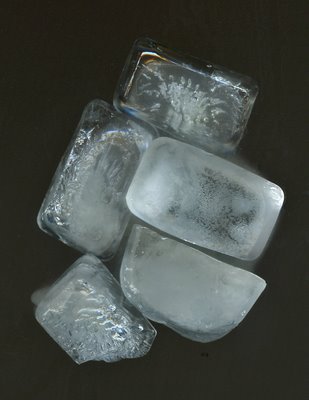
If I were to tell my Rebecca that I flew in a DC-3 she would not know what I was talking about. If I told her that in Buenos Aires we had our ice delivered every four days by the hielero (the ice man) and that a cloaquero or drain man came to my house to clear our drains once a month (the stench!), she would not understand. She is from a generation that has no reason to look up into the sky when it hears the noise of an airplane.
But she is not all that far gone. A few years ago I took her to the Abbotsford Air Show and I asked her which airplane was her favourite. Her reply was instant, "I like the F-15 because it is the loudest."
When Rebecca comes over on Saturdays the first thing she does is raid our refrigerator. I would never tell her not to. I remember the first time I opened a refrigerator door. It was exciting. After all it was in 1952 and I was ten. Until that year that hielero had delivered a block of ice (I am not sure) about once a week. But since my mother, who taught at the Buenos Aires American School, had friends and connections with the US Embassy she brought home stuff like poppy seed bagels, Erector sets, Bazooka and Double Bubble gum, and that wonderful used Kelvinator which made me king of the block. A neighbour had a spanking new Ford V-8 but that was nothing compared to our heladera. In the heladera I made my first package of lime Jell-O. Royal, the Argentine brand, wasn't good enough and lemon Royal was simply not green at all! I remember concocting what I called a refrigerio. I would slice sweet oranges. Scraping at them with a spoon was a delight. The most beautiful aspect of our heladera is that it had the compressor motor sitting on the top. Looking back I think it resembled a Russian space station.
The heladera became a refrigerador in Mexico City but my mother insisted it be a Kelvinator. When my mother moved to Veracruz in the late 50s she bought a Kelvinator there. We brought that Kelvinator back to Mexico City when Rosemary and I installed ourselves in the outskirts of Mexico City. We quickly outgrew it. We needed a bigger one. I sold the the Kelvinator to one of my English students. A day later I received an irate call from her. She was sending it back. It was disgusting she protested. I had not checked the back of the fridge and it had traveled from Veracruz with nests of cockroaches. The insect was impossible to erradicate in Veracruz and we had learned to live with them. In the end we scrapped it and bought a Kenmore at Sears Roebuck the Mexico.
Every once in a while when Rebecca raids our present Kenmore (the Richmond store) she asks me to read her a poem that is one of our favourites. And when I do so she repeats the words at the same time as she knows it by heart. This Is Just To Say
I have eaten
the plums
that were in
the icebox
and which
you were probably
saving
for breakfast
Forgive me
they were delicious
so sweet
and so cold
William Carlos Williams.
To further complicate matters, Spaniards call the Argentine heladera and the Mexican refrigerador a frigorífico. My Spanish grandmother made it much more simple. She always called it la Kelvinator. Because of fluctuating voltage in Latin America, fridges never last more than a couple of years before their compressor motors burn out. The rewiring of the motor cores is a thriving business. The mechanic shops advertise as rebobinado (re-coring). Since the freon or the freon substitute coolant gas escapes during this operation there is another business....
Deep Throat - Chuck Traynor & My New London Fog
Monday, December 10, 2007
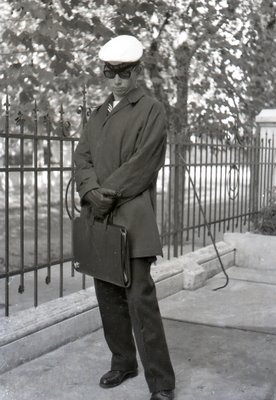
The last real overcoat I ever owned was when I was a child. It was a hand-me-down from my rich cousin Robin Tow whose father owned the ritzy Buenos Aires department store, Casa Tow in the late 40s. In Argentina the overcoat was never called an abrigo (Spanish for coat) but a sobretodo which means "over everything". When we moved to Mexico City it never really got cold enough for one. In my 5 years in Austin, Texas it was bitterly cold in winter but I got by with rain jackets.
It was in the Argentine Navy that I was issued something close to an overcoat. We called it a gabán. It was a poor quality canvas type blue raincoat. It had a cheap removable lining that was made of Argentine wool. It kept me warm even in those humid Buenos Aires winters when you could smell the River Plate as it sent cold winds that would sneak up Calle Corrientes. I would often walk up Corrientes to bars that served submarinos. These were glasses of scalding hot milk held by a metal cup and served with a long spoon and a large bar of bitter chocolate that melted away the cold.
In 1974 Rosemary, my two daughters Ale (6), Hilary (3) and I drove, from Mexico in our VW beetle to a holiday in San Francisco. One afternoon I went to an army surplus store and bought me a US Air Force overcoat that was a middle blue, double breasted with nice metal buttons. The material was like a thick wool blanket. It was heavy and it kept me warm. Because we had been teaching English in Westin Hotels in Mexico City we had a heavy discount at the St Francis Hotel on Union Square. On my way back (wearing my blue overcoat) to the hotel I decided to see a film I had read so much about. It was Deep Throat. This was the first pornographic film I ever saw. I never saw another. In front of me were two black men eating from huge bags of pop corn and exchanging loud comments on what was happening on screen. From then on I always associated my overcoat with that film. I wore it in Vancouver until age finally made me realize I was not going to be thin all my life the way my father had been. The coat felt tight and I got rid of it. Since then I have made do with raincoats over sweaters or simply braved the cold between my parked car and walking with Rosemary to the opera or the ballet at the Queen Elizabeth Theatre.
In the early 80s I photographed porn star Marilyn Chambers in her Four Season's Hotel room in Vancouver. Nearby was the scary man Chuck Traynor who had been Linda Lovelace's manager when Lovelace filmed Deep Throat. He was Chamber's manager. When writer Les Wiseman and I left Chambers and Traynor we felt a chill go over us.
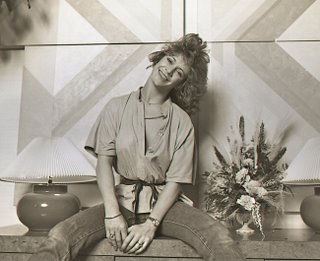
Sometime in the mid 90s Wiseman and I passed by the Marble Arch and we entered to see a woman who was being billed as the new Marilyn Chambers. Her breasts had been augmented to resemble the engine nacelles of a B-24 Liberator bomber. Wiseman lost interest and beckoned us to leave. I stopped him when I pointed out the man who was taking the Polaroids of patrons posing by the Chambers replacement. "That's Chuck Traynor." It was and we promptly paid our $10 bucks each to have our picture taken. The whole point was not who was in the picture but who had taken it. I looked at Traynor and he never met my eyes. Wiseman told me he owed huge sums to the US tax department. He seemed to be almost another person. But he was still scary. The Polaroid disappeared in my library. Perhaps it is inside a book. Somehow when Traynor took my photograph the "stain" on my US Air Force overcoat disappeared from my memory.
I forgot all about it until this week when I finally bought myself my first real adult overcoat. It is a black, all wool London Fog. It is pristine and warm. I am a happy man.
The Pointe Of It All - Max Wyman - A Dancing Shoe Aficionado
Sunday, December 09, 2007
Yesterday was a sort of a dancing red letter day. At noon I photographed in my studio Grant Strate (about to be 80) who is a founding member of the National Ballet of Canada. After watching The Red Balloon as a visual appetizer for Rebecca and Lauren, the three of us watched Robert Altman's The Company (with Neve Campbell who also wrote the story). This is a dance film, part documentary which really is only for the serious aficionado. I was pleased that both Lauren and Rebecca enjoyed it. When Rebecca watched real dancer Neve Campbell remove bandaids and tape from her sore toes she remarked how ugly her feet were. I remembered asking Ballet BC dancer Lauri Stallings (photo in colour) if I could photograph her feet. "They are so ugly, "she said, "Why would you want to do something like that?" I wanted to and I did. I discovered a whole new world (notice that Stallings has her name and a personal number on the soles of her custom-made shoes). It was a world that Wyman completed in spades in his essay below. It all began when someone at the Sun (Larry Emeric, I believe) told me that Wyman collected ballerina's pointe shoes. When I suggested a story to him he readily agreed. In those days you could dream up stories. Newspapers and magazines would run them. I miss those days as much as I miss Wyman's arts criticism and reviews. ---------------------------------------------------------------------------------------------------------------------------------- When the 19th - century ballerina Marie Taglioni rose in her toes in La Sylphide , effectively redefining the expressive potential of the art form, Russian fans were so enraptured that they cooked her slippers and ate them. 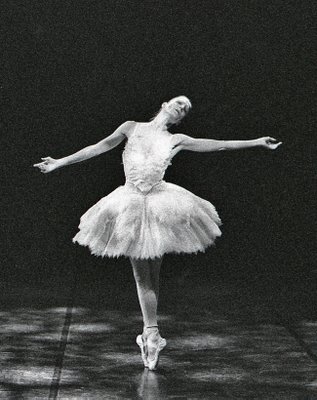 Dance fans have always been extreme, of course (and I'm not even thinking about the hard-core toe shoe fetishists who have their own members-only Web site). Drinking champagne from the ballerina's shoe used to be a popular way for stage-door Johnies to demonstrate their adoration ... though if you tried it today you might find your fizz flavoured by an aromatic modern anti-fungal cream. My own involvement amounts to a modest collection of signed, used shoes that function as memory-prods for some of the most sublime evenings I have spent in the theatre. Among them are several pairs from the magical Evelyn Hart, left,(as Juliet, as Odette/Odille, as Giselle), a pair from Karen Kain, and a pair I removed personally from the feet of Kirov Ballet's luminous Yulia Makhalina. 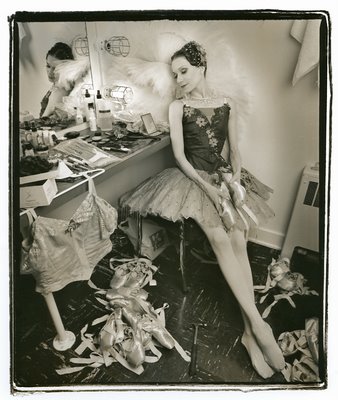 Yes, Personally - on my knees on a filthy floor, trying to avoid the scummy puddle from an overflowing sink, in a dressing room in the Maryinsky Theatre in St. Petersburg. She had just sent a packed house into a delirium of rythmic clapping a the end of Swan Lake, and here she was, bouquets still in her arms, flopped exhausted on a chair, letting me unlace the ribbons and ease the hot shoes from her exquisite feet. 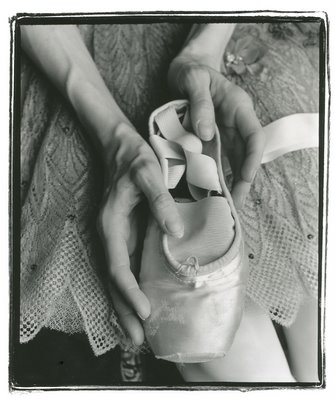 Well, perhaps you had to be there. Often, after all, dancers' feet are not a pretty sight. They bruise, they bleed, they develop bunions. Vancouver's Jean Orr, Canada's first Giselle, remembers the days when "we didn't have all the wonderful toe protectors they have today. We just bled into our shoes." Then she'd go home and scrub the dried blood out of the satin with a tooth brush. 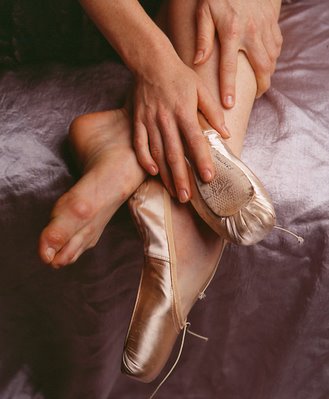 Realistically, there is no logical reason why human beings would want to dance on pointe . It's unnatural (human feet evolved the way they did for good and sensible reasons) and, for those who do it, it's uncomfortable and hugely painful. So why do it? In a word, for art. Taglioni, who premiered La Sylphide in 1832, probably wasn't the first to dance on pointe. The historians place its start as early as the beginning of the 19th century, maybe before, though the shoes in use then were hardly more than slippers, and dancers stayed on their toes for barely a second. Even Taglioni didn't have the benefit of today's hard blocked toe shoes, because they hadn't been invented. But she's the one who first used the trick to make an artistic impression. And that's the secret of its enduring appeal. Dancing on pointe reinforced the sense of ethereality and other-wordliness that was so vital to the Romantic ballet, with its tales of sprites and fairies and bewitchment. With feet that seem never to end, the ballerina seems to float, immortal, the epitome of feminine virtue, a spirit of the supernatural. 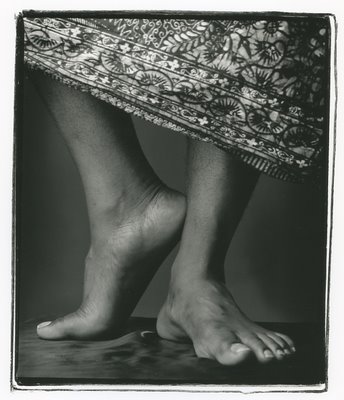 Examine the photograph on this page of Evelyn Hart in her dressing room. it's a typical dilemma for her: which shoes will she wear tonight? Will any of them be suitable? She will often try dozens before making a choice. 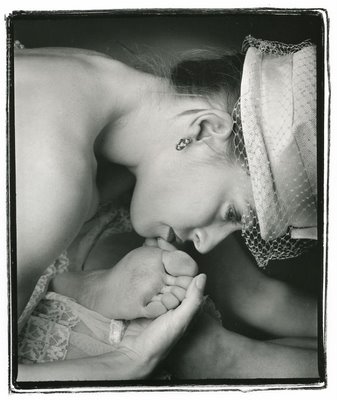 Like most professional dancers, Hart gets her shoes custom-made from cobblers who work to her unique last. Not that "cobbler" really defines the task. Ballet shoes are really layers of fabric and glue, baked to provide stiffness. They have a hard "platform" in the toe on which the dancer balances, and a series of thin leather and carboard soles. They don't usually come in lefts and rights; for that matter, a chosen pair may not actually match, since a dancer may have differently sized feet. But the making of the shoe is only the beginning of the adventure. New shoes are often stiff and need breaking in to allow unforced jumping and rising into pointe. A ballerina must sew on her ribbons, and most will make person adjustments, some of them scoring the soles to allow the foot more flexibility, some ripping out lining, some darning the toes for better grip. Since a principal dancer can get through a couple of pairs of shoes in a single performance, this is an endless process. The human foot is a complex structure. It consists of 26 bones, connected by ligaments. Seven bones form the instep; five metatarsals form the ball of the foot; 14 phalanges form the toes (two in the big toe, three in each of the others). 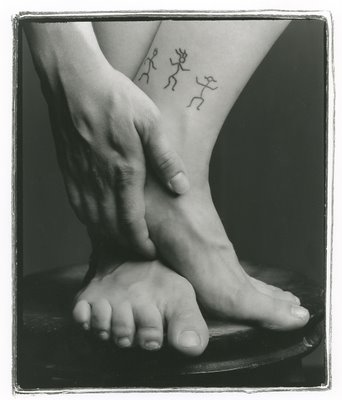 The ideal foot for a toe shoe has toes of nearly equal length; long big toes or second toes can be problematic, because they have to support the whole body weight. In the process of lengthening the line of the leg, the point shoe helps tone the calf muscles, and develops strength in the ankles and feet, which lets dancers handle more easily the technical demands of modern choreographers. The feet and legs are a dancer's most important tools, and they have to be treated accordingly. Dancers have their own rules for shoes. Keep the toenails trimmed short. Choose shoes that fit like a second skin - loose shoes promote blisters. (About three sizes smaller than your street shoes seems the preferred choice.) To prevent the rubbing that causes blisters and bleeding, many dancers line their shoes with lamb's wool or other padding (though cushioned shoes are also available these days). Foot binding with tape is common, and dancers will also wrap their feet in newspaper before inserting them into the toe shoe. Sometimes people use bits of cotton to separate the toes, and tape toes individually with Elastoplast. Synthetic skin, widely available at pharmacies helps staunch bleeding. Even modern dancers who work without shoes will tape individual toes to reduce friction, though many don't need to do that because years of barefoot work have developed protective calluses. Vancouver choreographer and former dancer, Judith Marcuse remembers using methylated spirits to toughen the skin so it wouldn't bleed and blister, though it was important to make sure that the calluses that were created didn't separate from the skin. Former Royal Winnipeg Ballet principal Leslie Fields, a Vancouverite now living on Bowen Island, had her own way of reducing swelling. She would go back to her hotel room after a performance, pour herself a drink, sit on the edge of the bath and stick her feet in the toilet. Repeated flushing kept a welcome flow of cold water on the suffering toes. It's equally important to keep the feet properly exercised. Isometrics are big these days. A lot of dancers travel with resistance bands to help strengthen foot and ankle muscles (Marcuse remembers using cycle-tire inner tubes for the same reason). Another preferred hotel-room oot exercise involves standing your toes on the edge of a telephone book and dropping your heels to the floor. Ballet historian Lincoln Kirstein called toe-dancing "the speech of the inexpressible," though of course all dancing is. Every step the dancer takes, every posture the body assumes, is visible; and yet, from that vocabulary of motion, a non visible language of ideas and emotions emerges. What pointe work contributes to this, along with all that ethereality, is a transformation of the line of the body - a re-proportioning of the torso and the leg's musculature that somehow lets us understand ideas like nobility and tenderness and power in new ways. When a ballerina poses, unsupported, secure, on a single point occupying only the tiniest piece of mortal ground, her body in immaculate balance, we have an illusion of transcendental achievement and serene glory that is as enviable as it is remote. When she bourrées with the precision and speed of a knitting-machine on her pointed toes across the stage in The Dying Swan, or when - in a modern ballet, let's say - she stabs the stage with an arched toe, she is bringing us more than mere beauty. She is expressing essential emotion that strikes, without the mediation of words, straight to the heart, straight to the soul. 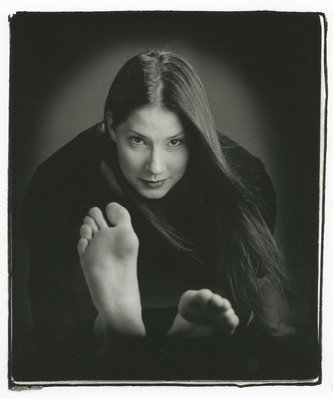 Today, of course, any and every form of movement is grist to the choreographer's mill, and the dancer's foot is called on to be more versatile than at any time in history. Look at the poised and healthy force in Laura Monteiro's resting feet, the tough undersides of Martha Lenonard's toes (wearing white hat), the gnarled, veined authority of Daylan Pflug, with those ankle tattoos of dancing stick figures. They're the tools that help the body speak the inexpressibles to us. If movement, as we are so often told, never lies, the feet are essential tools of truth. The Vancouver Sun, Saturday, February 24, 2001 When then veteran Sun reporter and editor Max Wyman wrote the above he had been named an officer of the Order of Canada a week before. He is currently dealing with mud slides in his job of mayor of Lion's Bay. I am sure that his pointe shoe collection has grown considerably since then. I have added two pictures here which were not used by the Sun for lack of room. One is of Evelyn Hart en pointe in the Dying Swan and the other is of Emily Molnar (the last photograph above) showing off her feet.
|

































